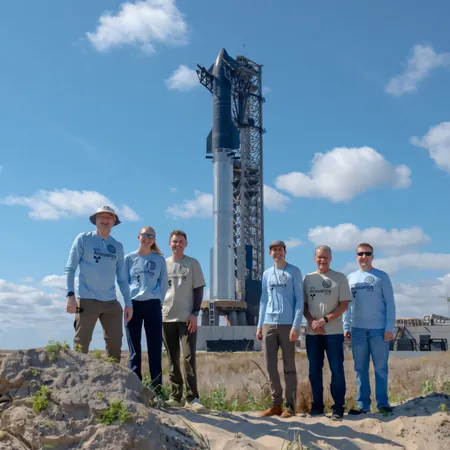
Unraveling the Sonic Mystique of SpaceX's Starship: How Rocket Roars Resound in Communities and Nature
2024-11-19
Author: Arjun
The Experience of Launching Starship
Witnessing the launch of SpaceX's Starship, the largest and most powerful rocket ever built, is an experience like no other, and one that leaves a lasting impact on both individuals and the environment. Imagine being there, surrounded by a mix of excitement and sheer noise—this is exactly what BYU student Noah Pulsipher experienced during a recent launch in October.
"It's the loudest thing I've ever heard—it's like the sound is physically pushing you back," Pulsipher described, noting the cacophony around him, where car alarms blared and dogs barked in reaction to the sonic boom. "It's an overwhelming yet powerful experience."
Research on Rocket Sounds
Pulsipher is part of a dedicated team at BYU's Physics and Aerospace Student-Centered Acoustics Laboratory (PASCAL), led by distinguished professor Kent Gee. Known for his extensive research on high-amplitude rocket sounds, Gee highlighted the distinct audio signature of the Starship launch: "It has this low-frequency rumble that is truly overwhelming combined with a high-frequency popping sound—what I like to call a 'crackle'. It’s a unique auditory experience that cannot be ignored."
The research team has recently published findings in a paper in JASA Express Letters following exhaustive measurements taken during Starship's fifth flight. Astonishingly, even 10 kilometers away from the launch site, the sound was comparable to that of a rock concert. At a distance of 20 kilometers, it rivaled the noise of power tools like table saws, and it remained noticeable even kilometers further away, akin to household appliances such as vacuum cleaners.
Volume and Community Impact
In terms of sheer volume, a single Starship launch emits noise equivalent to four to six launches of NASA's Space Launch System or at least ten launches of the Falcon 9. With plans for up to 100 Starship launches a year, the potential disruption to local communities grows concerning. The implications might extend beyond just noise—with disturbances to sleep, setting off alarms, and an impact on local wildlife expected, these factors pose important questions about environmental stewardship and community life.
“We are a space-faring society now, which brings a delicate responsibility,” Gee emphasized. “It's vital to find a balance between our ambitions for space exploration and our role as caretakers of the environment. Our research aims to explore how these launches may affect threatened or endangered species and the quality of life within nearby communities.”
Regulatory Considerations
Interestingly, there are currently no established regulatory limits concerning rocket noise, meaning that PASCAL's ongoing research could significantly inform policies in the future as spaceports proliferate.
The Journey to Future Flights
As the team prepared for Starship's sixth flight on November 19, they transported essential equipment—computers, data acquisition systems, GPS devices, microphones, and protective windscreens—to Texas. This hands-on project is a unique educational opportunity for students, positioning BYU as a pioneer in comprehensive rocket acoustics research.
Awe and Inspiration
For Pulsipher, the excitement of rocket launches remains unparalleled. "Watching a rocket go off is always awe-inspiring—the moment you see the light and then hear the sound, it just takes your breath away. It’s an unforgettable experience, and I can't wait for the next one."
Conclusion
As humanity pushes the boundaries of space exploration, the roar of rockets serves as a powerful reminder of our responsibilities on Earth and the intricate balance between innovation and environmental consciousness. Stay tuned, because as SpaceX continues to soar, the world will be listening!

 Brasil (PT)
Brasil (PT)
 Canada (EN)
Canada (EN)
 Chile (ES)
Chile (ES)
 España (ES)
España (ES)
 France (FR)
France (FR)
 Hong Kong (EN)
Hong Kong (EN)
 Italia (IT)
Italia (IT)
 日本 (JA)
日本 (JA)
 Magyarország (HU)
Magyarország (HU)
 Norge (NO)
Norge (NO)
 Polska (PL)
Polska (PL)
 Schweiz (DE)
Schweiz (DE)
 Singapore (EN)
Singapore (EN)
 Sverige (SV)
Sverige (SV)
 Suomi (FI)
Suomi (FI)
 Türkiye (TR)
Türkiye (TR)